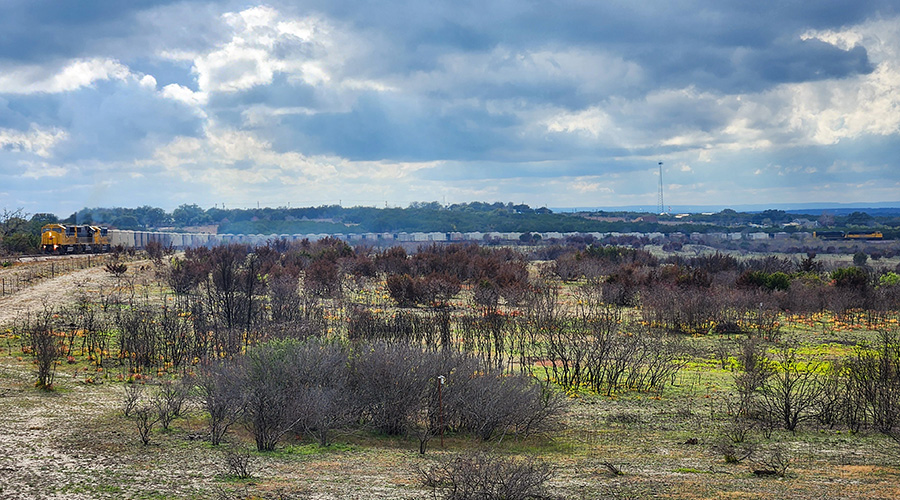Watco short line takes on distributed power in Texas
4/1/2024
By Jeff Stagl, Managing Editor
Short lines don’t typically have the resources or means to implement something that’s more akin to Class Is’ modus operandi. But Watco’s Austin Western Railroad (AWRR) is aiming to buck that trend.
The Texas short line is nearing the completion of equipping 10 of its locomotives with a distributed power (DP) system, which is more widely used by Class Is. AWRR operates 205 miles of track between Llano and Giddings, Texas, and interchanges with BNSF Railway Co. and Union Pacific Railroad in McNeil, Texas.
 The Austin Western Railroad operates 205 miles of track between Llano and Giddings, Texas, and interchanges with BNSF Railway Co. and Union Pacific Railroad. Watco
The Austin Western Railroad operates 205 miles of track between Llano and Giddings, Texas, and interchanges with BNSF Railway Co. and Union Pacific Railroad. WatcoThe short line has used DP when a Class I has interchanged trains already equipped with the system, but not solely on its own.
“This is a new project for us to begin installing the system on our owned locomotives,” said Watco Marketing Specialist Jay Benedict in an email.
DP enables AWRR to position its locomotives at different points on the train, typically at each end. All the locomotives communicate with each other and are operated by a single train crew. Watco is working on the project with vendor Precision Train Control Services.
DP’s major advantages include: the ability to operate longer and heavier trains; better train handling and diminished break-in-two risks; faster starting, stopping and brake pipe charging; less friction in curves; reduced rail and wheel wear; increased safety; and fuel savings.
DP provides crews better control of their trains, said Ben Tarran, Watco’s director of locomotive support and the project’s lead.
The AWRR is an ideal candidate for DP because of the geography along its lines — which includes steep 1.5% to 3% grades and curves — and the commodities the railroad hauls, including heavy rocks, said Tarran. Train size, tonnage and a customer’s desire to haul more cars also factored into the decision to adopt the technology.
The AWRR features a unique mix of rural, urban and mixed-use rail, said Benedict.
“Outside of Austin, the track winds through hills. Near and in Austin, we share the rail with commuter trains,” he said. “And traffic has been growing — demand for aggregates and other construction commodities is growing. That means longer, heavier trains.”
Discussions about employing DP and electronic air brakes at the AWRR began in early 2022.
“As with any major locomotive upgrade, a lot has to go into the final decision: cost, location, what type of locomotives and trains it will be used on, and the overall benefits,” said Tarran.
 Watco worked with Precision Train Control Services to develop and implement a DP system on 10 AWRR locomotives. Watco
Watco worked with Precision Train Control Services to develop and implement a DP system on 10 AWRR locomotives. WatcoBy mid-2022, the project was approved. Then, meetings were held with the vendor and the contractors designing the system to work with AWRR’s locomotives.
Purchasing a DP system is the easiest part; getting it to work with your locomotives is a time-consuming and more complicated process, Tarran stressed. That effort entails conducting surveys on the locomotives, designing electrical prints that tie into the existing systems and purchasing parts that aren’t included, he said. Plus, wiring harnesses and circuit boards needed to be built from scratch before the control units could be integrated.
“Since we were also moving the existing PTC from our SD40s to the SD60s that we were installing the DP into, we had to work with transportation to keep the trains running and do this project at the same time,” said Tarran.
In January 2023, the first three DP kits arrived at the AWRR and the project began. By the end of October 2023, all the kits had been received.
The short line now is operating eight DP-equipped locomotives and no problems have been encountered so far, said Tarran. But it’s taking longer than anticipated to equip the last two locomotives.
“Our plan was to be completed by March. But the last two kits have had some component failures and had to be returned for warranty,” said Tarran. “The estimated completion now looks like May.”
Since AWRR crews need to be trained on DP — because trains equipped with the system handle differently — a DP program was created for the short line’s locomotive simulators.
Now, Watco officials are trying to determine if employing DP makes sense at some of the company’s other short lines.
“Railroads in mountainous areas like West Virginia and North Carolina are potential areas for next steps with DP,” said Benedict.



